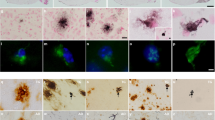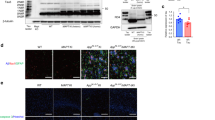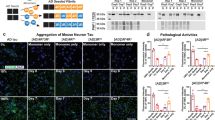Abstract
The simultaneous presence of intracellular neurofibrillary tangles (NFT) and extracellular senile plaques in Alzheimer's disease (AD) suggests that the two lesions could be synergistically interrelated. However, although the main protein components of NFT and senile plaques, τ (tau) and amyloid β-protein, respectively, are well characterized, the molecular mechanisms responsible for their deposition in lesions are unknown. We demonstrate, using four independent techniques, that τ directly interacts with a conformation-dependent domain of the amyloid β-protein precursor (βPP) encompassing residues βPP714–723. The putative τ–binding domain includes βPP717 mutation sites that are associated with familial forms of AD. Our findings strongly suggest that NFT and senile plaques, often thought of as independent structures, may play a role in each other's formation during the pathogenesis of AD.
This is a preview of subscription content, access via your institution
Access options
Subscribe to this journal
Receive 12 print issues and online access
$209.00 per year
only $17.42 per issue
Buy this article
- Purchase on Springer Link
- Instant access to full article PDF
Prices may be subject to local taxes which are calculated during checkout
Similar content being viewed by others
References
Alzheimer, A. ¨ber eine eigenartige Erkrankung der Hirnrinde. Zentralbl. Ger. Neural. Psychiat. 18, 177–179 (1907).
Grundke-Iqbal, I. et al. Abnormal phosphorylation of the microtubule-associated protein τ in Alzheimer cytoskeletal pathology. Proc. natn. Acad. Sci. U.S.A. 83, 4913–4917 (1986).
Masters, C.L. et al. Amyloid plaque protein in Alzheimer disease and Down syndrome. Proc. natn. Acad. Sci. U.S.A. 82, 4245–4249 (1985).
Perry, G. Neuritic plaques in Alzheimer disease originate from neurofibrillary tangles. Med. Hypotheses. 40, 257–258 (1993).
Perry, G., Brinkley, B.R. & Bryan, J. Interaction of calcium-calmodulin in microtubule assembly in vitro . in Muscle and Cell Motility (eds. Dowben, R.M. & Shay, J.W.), 73–84 Vol 2 (Plenum Press, New York, 1982).
Davies, L. et al. A4 amyloid protein deposition and the diagnosis of Alzheimer's disease. Neurology 38, 1688–1693 (1988).
Kim, K.S. et al. Production and characterization of monoclonal antibodies reactive to synthetic cerebrovascular amyloid peptide. Neurosci. Res. Commun. 2, 121–130 (1988).
Cras, P. et al. Neuronal and microglial involvement in β-amyloid deposition in Alzheimer disease. Am. J. Pathol. 137, 241–246 (1990).
Shoji, M. et al. Production of the Alzheimer amyloid beta protein by normal proteolytic processing. Science. 258, 126–129 (1992).
Perry, G. et al. Amyloid precursor protein in senile plaques of Alzheimer disease. Lancet ii, 746 (1988).
Roher, A.E., Palmer, K.C., Yurewicz, E.C., Ball, M.J. & Greenberg, B.D. Morphological and biochemical analyses of amyloid plaque core proteins purified from Alzheimer disease tissue. J. Neurochem. 61, 1916–1926 (1993).
Ellisman, M. et al. Neuronal fibrillar cytoskeletal and endomembrane system organization in Alzheimer's disease. Alterations in the Neuronal Cytoskeleton in Alzheimer Disease (ed. Perry, G.), 61–73 (Plenum Press, New York, 1987).
Maggio, J.E. et al. Reversible in vitro growth of Alzheimer disease beta-amyloid plaques by deposition of labelled amyloid peptide. Proc. natn. Acad. Sci. U.S.A. 89, 5462–5466 (1992).
Goate, A. et al. Segregation of a missense mutation in the amyloid precursor protein gene with familial Alzheimer's disease. Nature 349, 704–706 (1991).
Kang, J. et al. The precursor of Alzheimer's disease amyloid A4 protein resembles a cell-surface receptor. Nature 325, 733–736 (1987).
Smith, M.A. et al. Advanced Maillard reaction products are associated with Alzheimer disease pathology. Proc. natn. Acad. Sci. U.S.A. 91, 5710–5714 (1994).
Perry, G. et al. Immunocytochemical evidence that the β-protein precursor is an integral component of neurofibrillary tangles. Am. J. Pathol. 143, 1586–1593 (1993).
Autilio-Gambetti, L. et al. The amyloid precursor protein of Alzheimer disease is expressed as a 130kDa polypeptide in various cultured cell types. FEBS Lett. 241, 94–98 (1988).
Refolo, L.M., Wittenberg, I.S., Friedrich, V.L. Jr. & Robakis, N.K. Alzheimer amyloid precursor is associated with the detergent-insoluble cytoskeleton. J. Neurosci. 11, 3888–3897 (1991).
Kawai, M. et al. Degeneration of vascular muscle cells in cerebral amyloid angiopathy of Alzheimer disease. Brain Res. 623, 142–146 (1993).
Prelli, F., Castano, E., Glenner, G.G. & Frangione, B. Difference between vascular and plaque core amyloid in Alzheimer's disease. J. Neurochem. 51, 648–651 (1988).
Golde, T.E., Estus, S., Younkin, L.H., Selkoe, D.J. & Younkin, S.G. Processing of the amyloid precursor protein to potentially amyloidogenic derivatives. Science 255, 728–730 (1992).
Fraser, P.E., Nguyen, J.T., McLachlan, D.R., Abraham, C.R. & Kirschner, D.A. Alpha-1-antichymotrypsin binding to Alzheimer Aβ peptides is sequence specific and induces fibril disaggregation in vitro . J. Neurochem. 61, 298–305 (1993).
Kalaria, R.N., Galloway, P.G. & Perry, G. Widespread serum amyloid P immunoreactivity in cortical amyloid deposits and the neurofibrillary pathology of Alzheimer's disease and other degenerative disorders. Neuropathol. App. Neurobiol. 17, 189–201 (1991).
Strittmatter, W.J. et al. Binding of human apolipoprotein E to synthetic amyloid beta peptide: Isoform-specific effects and implications for late-onset Alzheimer disease. Proc. natn. Acad. Sci. U.S.A. 90, 8098–8102 (1993).
Vitek, M.P. et al. Advanced glycation end products contribute to amyloidosis in Alzheimer disease. Proc. natn. Acad. Sci. U.S.A. 91, 4766–4770 (1994).
Wille, H., Drewes, G., Biernat, J., Mandelkow, E.M. & Mandelkow, E. Alzheimer-like paired helical filaments and antiparallel dimers formed from microtubule-associated protein tau in vitro. J. Cell Biol. 118, 573–584 (1992).
Caputo, C.B., Sygowski, L.A., Scott, C.W. & Sobel, I.R. Role of tau in the polymerization of peptides from the beta-amyloid precursor protein. Brain Res. 597, 227–232 (1992).
Connolly, J.A., Kalnins, V.I., Cleveland, D.W. & Kirschner, M.W. Immunofluorescent staining of cytoplasmic and spindle microtubules in mouse fibroblasts with antibody to tau protein. Proc. natn. Acad. Sci. U.S.A. 74, 2437–2440 (1977).
Selden, S.C. & Pollard, T.D. Phosphorylation of microtubule-associated proteins regulates their interaction with actin filaments. J. biol. Chem. 258, 7064–7071 (1983).
Miyata, Y., Hoshi, M., Nishida, E., Minami, Y. & Sakai, H. Binding of microtubule-associated protein 2 and tau to the intermediate filament reassembled from neurofilament 70-kDa subunit protein. J. biol. Chem. 261, 13026–13030 (1986).
Shin, R.-W., Bramblett, G.T., Lee, V.M.-Y. & Trojanowski, J.Q. Alzheimer disease A68 proteins injected into rat brain induce co-deposits of β-amyloid, ubiquitin and α1-antichymotrypsin. Proc. natn. Acad. Sci. U.S.A. 90, 6825–6828 (1993).
Lindwall, G. & Cole, R.D. The purification of tau protein and the occurrence of two phosphorylation states of tau in brain. J. biol. Chem. 259, 12241–12245 (1984).
Lee, V.M.-Y., Balin, B.J., Otvos, L. Jr. & Trojanowski, J.Q. A68: a major sub-unit of paired helical filaments and derivatized forms of normal tau. Science 251, 675–678 (1991).
Kalaria, R.N., Sromek, S.M., Grahovac, I. & Harik, S.I. Transferin receptors of rat and human brain and cerebral microvessels and their status in Alzheimer's disease. Brain Res. 585, 87–93 (1992).
Author information
Authors and Affiliations
Rights and permissions
About this article
Cite this article
Smith, M., Siedlak, S., Richey, P. et al. Tau protein directly interacts with the amyloid β-protein precursor: Implications for Alzheimer's disease. Nat Med 1, 365–369 (1995). https://doi.org/10.1038/nm0495-365
Received:
Accepted:
Issue Date:
DOI: https://doi.org/10.1038/nm0495-365
This article is cited by
-
APP mediates tau uptake and its overexpression leads to the exacerbated tau pathology
Cellular and Molecular Life Sciences (2023)
-
Bee venom phospholipase A2 ameliorates Alzheimer’s disease pathology in Aβ vaccination treatment without inducing neuro-inflammation in a 3xTg-AD mouse model
Scientific Reports (2018)
-
Enduring Elevations of Hippocampal Amyloid Precursor Protein and Iron Are Features of β-Amyloid Toxicity and Are Mediated by Tau
Neurotherapeutics (2015)
-
Tau deficiency induces parkinsonism with dementia by impairing APP-mediated iron export
Nature Medicine (2012)
-
The difference in gliosis induced by β-amyloid and Tau treatments in astrocyte cultures derived from senescence accelerated and normal mouse strains
Biogerontology (2009)



